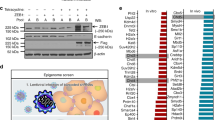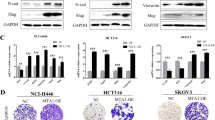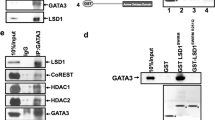Abstract
The acquisition of an invasive phenotype by epithelial cells occurs through a loss of cellular adhesion and polarity, heralding a multistep process that leads to metastatic dissemination. Since its characterization in 1995, epithelial–mesenchymal transition (EMT) has been closely linked to the metastatic process. As a defining aspect of EMT, loss of cell adhesion through downregulation of E-cadherin is carried out by several transcriptional repressors; key among them the SNAI family of transcription factors. Here we identify for the first time that Lyn kinase functions as a key modulator of SNAI family protein localization and stability through control of the Vav-Rac1-PAK1 (Vav-Rac1-p21-activated kinase) pathway. Accordingly, targeting Lyn in vitro reduces EMT and in vivo reduces metastasis of primary tumors. We also demonstrate the clinical relevance of targeting Lyn as a key player controlling EMT; patient samples across many cancers revealed a strong negative correlation between Lyn and E-cadherin, and high Lyn expression in metastatic tumors as well as metastasis-prone primary tumors. This work reveals a novel pancancer mechanism of Lyn-dependent control of EMT and further underscores the role of this kinase in tumor progression.
This is a preview of subscription content, access via your institution
Access options
Subscribe to this journal
Receive 50 print issues and online access
$259.00 per year
only $5.18 per issue
Buy this article
- Purchase on Springer Link
- Instant access to full article PDF
Prices may be subject to local taxes which are calculated during checkout






Similar content being viewed by others
References
Oppermann H, Levinson AD, Varmus HE, Levintow L, Bishop JM . Uninfected vertebrate cells contain a protein that is closely related to the product of the avian sarcoma virus transforming gene (src). Proc Natl Acad Sci USA 1979; 76: 1804–1808.
Parsons SJ, Parsons JT . Src family kinases, key regulators of signal transduction. Oncogene 2004; 23: 7906–7909.
Lowell CA . Src-family kinases: rheostats of immune cell signaling. Mol Immunol 2004; 41: 631–643.
Maness PF, Beggs HE, Klinz SG, Morse WR . Selective neural cell adhesion molecule signaling by Src family tyrosine kinases and tyrosine phosphatases. Perspect Dev Neurobiol 1996; 4: 169–181.
Thiery JP, Acloque H, Huang RY, Nieto MA . Epithelial–mesenchymal transitions in development and disease. Cell 2009; 139: 871–890.
Fidler IJ . The pathogenesis of cancer metastasis: the 'seed and soil' hypothesis revisited. Nat Rev Cancer 2003; 3: 453–458.
Zhang S, Yu D . Targeting Src family kinases in anti-cancer therapies: turning promise into triumph. Trends Pharmacol Sci 2012; 33: 122–128.
Guarino M . Src signaling in cancer invasion. J Cell Physiol 2010; 223: 14–26.
Zardan A, Nip KM, Thaper D, Toren P, Vahid S, Beraldi E et al. Lyn tyrosine kinase regulates androgen receptor expression and activity in castrate-resistant prostate cancer. Oncogenesis 2014; 3: e115.
Bougeret C, Jiang S, Keydar I, Avraham H . Functional analysis of Csk and CHK kinases in breast cancer cells. J Biol Chem 2001; 276: 33711–33720.
Bates RC, Edwards NS, Burns GF, Fisher DE . A CD44 survival pathway triggers chemoresistance via lyn kinase and phosphoinositide 3-kinase/Akt in colon carcinoma cells. Cancer Res 2001; 61: 5275–5283.
Stettner MR, Wang W, Nabors LB, Bharara S, Flynn DC, Grammer JR et al. Lyn kinase activity is the predominant cellular SRC kinase activity in glioblastoma tumor cells. Cancer Res 2005; 65: 5535–5543.
Ingley E . Functions of the Lyn tyrosine kinase in health and disease. Cell Commun Signal 2012; 10: 21.
Guan H, Zhou Z, Gallick GE, Jia SF, Morales J, Sood AK et al. Targeting Lyn inhibits tumor growth and metastasis in Ewing's sarcoma. Mol Cancer Ther 2008; 7: 1807–1816.
Choi YL, Bocanegra M, Kwon MJ, Shin YK, Nam SJ, Yang JH et al. LYN is a mediator of epithelial–mesenchymal transition and a target of dasatinib in breast cancer. Cancer Res 2010; 70: 2296–2306.
Yoo SK, Starnes TW, Deng Q, Huttenlocher A . Lyn is a redox sensor that mediates leukocyte wound attraction in vivo. Nature 2011; 480: 109–112.
Kantarjian H, le Coutre P, Cortes J, Pinilla-Ibarz J, Nagler A, Hochhaus A et al. Phase 1 study of INNO-406, a dual Abl/Lyn kinase inhibitor, in Philadelphia chromosome-positive leukemias after imatinib resistance or intolerance. Cancer 2010; 116: 2665–2672.
Peinado H, Olmeda D, Cano A . Snail, Zeb and bHLH factors in tumour progression: an alliance against the epithelial phenotype? Nat Rev Cancer 2007; 7: 415–428.
Grasso CS, Wu YM, Robinson DR, Cao X, Dhanasekaran SM, Khan AP et al. The mutational landscape of lethal castration-resistant prostate cancer. Nature 2012; 487: 239–243.
Holzbeierlein J, Lal P, LaTulippe E, Smith A, Satagopan J, Zhang L et al. Gene expression analysis of human prostate carcinoma during hormonal therapy identifies androgen-responsive genes and mechanisms of therapy resistance. Am J Pathol 2004; 164: 217–227.
Taylor BS, Schultz N, Hieronymus H, Gopalan A, Xiao Y, Carver BS et al. Integrative genomic profiling of human prostate cancer. Cancer Cell 2010; 18: 11–22.
Tomlins SA, Mehra R, Rhodes DR, Cao X, Wang L, Dhanasekaran SM et al. Integrative molecular concept modeling of prostate cancer progression. Nat Genet 2007; 39: 41–51.
Yu YP, Landsittel D, Jing L, Nelson J, Ren B, Liu L et al. Gene expression alterations in prostate cancer predicting tumor aggression and preceding development of malignancy. J Clin Oncol 2004; 22: 2790–2799.
Bos PD, Zhang XH, Nadal C, Shu W, Gomis RR, Nguyen DX et al. Genes that mediate breast cancer metastasis to the brain. Nature 2009; 459: 1005–1009.
Hatzis C, Pusztai L, Valero V, Booser DJ, Esserman L, Lluch A et al. A genomic predictor of response and survival following taxane-anthracycline chemotherapy for invasive breast cancer. JAMA 2011; 305: 1873–1881.
Kao KJ, Chang KM, Hsu HC, Huang AT . Correlation of microarray-based breast cancer molecular subtypes and clinical outcomes: implications for treatment optimization. BMC Cancer 2011; 11: 143.
Minn AJ, Gupta GP, Siegel PM, Bos PD, Shu W, Giri DD et al. Genes that mediate breast cancer metastasis to lung. Nature 2011; 436: 518–524.
Blaveri E, Simko JP, Korkola JE, Brewer JL, Baehner F, Mehta K et al. Bladder cancer outcome and subtype classification by gene expression. Clin Cancer Res 2005; 11: 4044–4055.
Dyrskjot L, Kruhoffer M, Thykjaer T, Marcussen N, Jensen JL, Moller K et al. Gene expression in the urinary bladder: a common carcinoma in situ gene expression signature exists disregarding histopathological classification. Cancer Res 2004; 64: 4040–4048.
Modlich O, Prisack HB, Pitschke G, Ramp U, Ackermann R, Bojar H et al. Identifying superficial, muscle-invasive, and metastasizing transitional cell carcinoma of the bladder: use of cDNA array analysis of gene expression profiles. Clin Cancer Res 2004; 10: 3410–3421.
Sanchez-Carbayo M, Socci ND, Lozano J, Saint F, Cordon-Cardo C . Defining molecular profiles of poor outcome in patients with invasive bladder cancer using oligonucleotide microarrays. J Clin Oncol 2006; 24: 778–789.
Stransky N, Vallot C, Reyal F, Bernard-Pierrot I, de Medina SG, Segraves R et al. Regional copy number-independent deregulation of transcription in cancer. Nat Genet 2006; 38: 1386–1396.
Pecina-Slaus N . Tumor suppressor gene E-cadherin and its role in normal and malignant cells. Cancer Cell Int 2003; 3: 17.
Gao J, Aksoy BA, Dogrusoz U, Dresdner G, Gross B, Sumer SO et al. Integrative analysis of complex cancer genomics and clinical profiles using the cBioPortal. Sci Signal 2013; 6: pl1.
Kasahara K, Nakayama Y, Ikeda K, Fukushima Y, Matsuda D, Horimoto S et al. Trafficking of Lyn through the Golgi caveolin involves the charged residues on alphaE and alphaI helices in the kinase domain. J Cell Biol 2004; 165: 641–652.
Yokota A, Kimura S, Masuda S, Ashihara E, Kuroda J, Sato K et al. INNO-406, a novel BCR-ABL/Lyn dual tyrosine kinase inhibitor, suppresses the growth of Ph+ leukemia cells in the central nervous system, and cyclosporine A augments its in vivo activity. Blood 2007; 109: 306–314.
Hibbs ML, Stanley E, Maglitto R, Dunn AR . Identification of a duplication of the mouse Lyn gene. Gene 1995; 156: 175–181.
Cancer Genome Atlas N. Comprehensive molecular portraits of human breast tumours. Nature 2012; 490: 61–70.
Shih JY, Yang PC . The EMT regulator slug and lung carcinogenesis. Carcinogenesis 2011; 32: 1299–1304.
Zhou BP, Deng J, Xia W, Xu J, Li YM, Gunduz M et al. Dual regulation of Snail by GSK-3beta-mediated phosphorylation in control of epithelial–mesenchymal transition. Nat Cell Biol 2004; 6: 931–940.
De Mesquita DD, Zhan Q, Crossley L, Badwey JA . p90-RSK and Akt may promote rapid phosphorylation/inactivation of glycogen synthase kinase 3 in chemoattractant-stimulated neutrophils. FEBS Lett 2001; 502: 84–88.
Stambolic V, Woodgett JR . Mitogen inactivation of glycogen synthase kinase-3 beta in intact cells via serine 9 phosphorylation. Biochem J 1994; 303 (Part 3): 701–704.
Yang Z, Rayala S, Nguyen D, Vadlamudi RK, Chen S, Kumar R . PAK1 phosphorylation of snail, a master regulator of epithelial-to-mesenchyme transition, modulates snail's subcellular localization and functions. Cancer Res 2005; 65: 3179–3184.
Brown JL, Stowers L, Baer M, Trejo J, Coughlin S, Chant J . Human Ste20 homologue hPAK1 links GTPases to the JNK MAP kinase pathway. Curr Biol 1996; 6: 598–605.
Stebbins CC, Watzl C, Billadeau DD, Leibson PJ, Burshtyn DN, Long EO . Vav1 dephosphorylation by the tyrosine phosphatase SHP-1 as a mechanism for inhibition of cellular cytotoxicity. Mol Cell Biol 2003; 23: 6291–6299.
Teng Y, Xie X, Walker S, White DT, Mumm JS, Cowell JK . Evaluating human cancer cell metastasis in zebrafish. BMC cancer 2013; 13: 453.
Jager W, Moskalev I, Janssen C, Hayashi T, Awrey S, Gust KM et al. Ultrasound-guided intramural inoculation of orthotopic bladder cancer xenografts: a novel high-precision approach. PLoS ONE 2013; 8: e59536.
Weigelt B, Peterse JL, van 't Veer LJ . Breast cancer metastasis: markers and models. Nat Rev Cancer 2005; 5: 591–602.
Hochgrafe F, Zhang L, O'Toole SA, Browne BC, Pinese M, Porta Cubas A et al. Tyrosine phosphorylation profiling reveals the signaling network characteristics of Basal breast cancer cells. Cancer Res 2010; 70: 9391–9401.
Gelman IH, Peresie J, Eng KH, Foster BA . Differential requirement for Src family tyrosine kinases in the initiation, progression, and metastasis of prostate cancer. Mol Cancer Res 2014; 12: 1470–1479.
Tabaries S, Annis MG, Hsu BE, Tam CE, Savage P, Park M et al. Lyn modulates Claudin-2 expression and is a therapeutic target for breast cancer liver metastasis. Oncotarget 2015; 6: 9476–9487.
Wu J, Meng F, Lu H, Kong L, Bornmann W, Peng Z et al. Lyn regulates BCR-ABL and Gab2 tyrosine phosphorylation and c-Cbl protein stability in imatinib-resistant chronic myelogenous leukemia cells. Blood 2008; 111: 3821–3829.
Ren X, Cao C, Zhu L, Yoshida K, Kharbanda S, Weichselbaum R et al. Lyn tyrosine kinase inhibits nuclear export of the p53 tumor suppressor. Cancer Biol Ther 2002; 1: 703–708.
Kim J, Bae S, An S, Park JK, Kim EM, Hwang SG et al. Cooperative actions of p21WAF1 and p53 induce Slug protein degradation and suppress cell invasion. EMBO Rep 2014; 15: 1062–1068.
Wu ZQ, Li XY, Hu CY, Ford M, Kleer CG, Weiss SJ . Canonical Wnt signaling regulates Slug activity and links epithelial-mesenchymal transition with epigenetic breast cancer 1, early onset (BRCA1) repression. Proc Natl Acad Sci USA 2012; 109: 16654–16659.
Kim JY, Kim YM, Yang CH, Cho SK, Lee JW, Cho M . Functional regulation of Slug/Snail2 is dependent on GSK-3beta-mediated phosphorylation. FEBS J 2012; 279: 2929–2939.
Vinas-Castells R, Beltran M, Valls G, Gomez I, Garcia JM, Montserrat-Sentis B et al. The hypoxia-controlled FBXL14 ubiquitin ligase targets SNAIL1 for proteasome degradation. J Biol Chem 2010; 285: 3794–3805.
Wang SP, Wang WL, Chang YL, Wu CT, Chao YC, Kao SH et al. P53 controls cancer cell invasion by inducing the MDM2-mediated degradation of Slug. Nat Cell Biol 2009; 11: 694–704.
Bid HK, Roberts RD, Manchanda PK, Houghton PJ . RAC1: an emerging therapeutic option for targeting cancer angiogenesis and metastasis. Mol Cancer Ther 2013; 12: 1925–1934.
Eswaran J, Li DQ, Shah A, Kumar R . Molecular pathways: targeting p21-activated kinase 1 signaling in cancer—opportunities, challenges, and limitations. Clin Cancer Res 2012; 18: 3743–3749.
Kumar R, Gururaj AE, Barnes CJ . P21-activated kinases in cancer. Nat Rev Cancer 2006; 6: 459–471.
Delaney MK, Liu J, Zheng Y, Berndt MC, Du X . The role of Rac1 in glycoprotein Ib-IX-mediated signal transduction and integrin activation. Arterioscler Thromb Vasc Biol 2012; 32: 2761–2768.
Rahaman SO, Swat W, Febbraio M, Silverstein RL . Vav family Rho guanine nucleotide exchange factors regulate CD36-mediated macrophage foam cell formation. J Biol Chem 2011; 286: 7010–7017.
Yazawa N, Fujimoto M, Sato S, Miyake K, Asano N, Nagai Y et al. CD19 regulates innate immunity by the toll-like receptor RP105 signaling in B lymphocytes. Blood 2003; 102: 1374–1380.
Cordonnier T, Bishop JL, Shiota M, Nip KM, Thaper D, Vahid S et al. Hsp27 regulates EGF/beta-catenin mediated epithelial to mesenchymal transition in prostate cancer. Int J Cancer 2015; 136: E496–E507.
Kilpinen S, Autio R, Ojala K, Iljin K, Bucher E, Sara H et al. Systematic bioinformatic analysis of expression levels of 17,330 human genes across 9,783 samples from 175 types of healthy and pathological tissues. Genome Biol 2008; 9: R139.
Acknowledgements
This work was supported by the Terry Fox Research Institute, Michael Smith Foundation, Prostate Cancer Canada and Canadian Institutes of Health Research. We would like to thank Dr Peter Black for the UC13 and UC13-luciferase cells, and Dr Yuzhou Wang for Oncomine access. We also appreciate the assistance of Eliana Beraldi and Shannon Awery for experimental support.
Author contributions
Conceptualization, design and interpretation of data: DT, SV, JLB and AZ; writing—original draft: DT; writing—review and editing, JLB, SV and AZ; in vitro data acquisition: DT, SV and KN; in silico data acquisition: DT; in vivo data acquisition (mouse): DT, SF and IM; in vivo data acquisition (zebrafish): DT, XS and CG-E; mice tissue: MER and KWH; funding acquisition and supervision: AZ.
Author information
Authors and Affiliations
Corresponding author
Ethics declarations
Competing interests
The authors declare no conflict of interest.
Additional information
Supplementary Information accompanies this paper on the Oncogene website
Supplementary information
Rights and permissions
About this article
Cite this article
Thaper, D., Vahid, S., Nip, K. et al. Targeting Lyn regulates Snail family shuttling and inhibits metastasis. Oncogene 36, 3964–3975 (2017). https://doi.org/10.1038/onc.2017.5
Received:
Revised:
Accepted:
Published:
Issue Date:
DOI: https://doi.org/10.1038/onc.2017.5
This article is cited by
-
Platinum-induced upregulation of ITGA6 promotes chemoresistance and spreading in ovarian cancer
EMBO Molecular Medicine (2024)
-
FBXO28 suppresses liver cancer invasion and metastasis by promoting PKA-dependent SNAI2 degradation
Oncogene (2023)
-
Epigenetic silencing of the ubiquitin ligase subunit FBXL7 impairs c-SRC degradation and promotes epithelial-to-mesenchymal transition and metastasis
Nature Cell Biology (2020)
-
Depletion of Csk preferentially reduces the protein level of LynA in a Cbl-dependent manner in cancer cells
Scientific Reports (2020)
-
Vav proteins maintain epithelial traits in breast cancer cells using miR-200c-dependent and independent mechanisms
Oncogene (2019)



